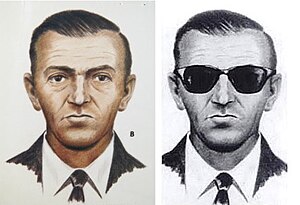yanomami.net – The D.B. Cooper hijacking remains one of the most intriguing unsolved mysteries in aviation history. On November 24, 1971, a man calling himself Dan Cooper (later referred to as D.B. Cooper) hijacked a Boeing 727 aircraft, extorted $200,000 in ransom, and then parachuted into the night, never to be seen again. This audacious act has captivated the public’s imagination for decades, spawning countless theories, investigations, and even a Hollywood movie.
The Hijacking
The story began when a man in a dark suit and tie purchased a one-way ticket on Northwest Orient Airlines Flight 305 from Portland, Oregon, to Seattle, Washington. Identifying himself as Dan Cooper, he took his seat among the other passengers, blending in without raising suspicion. However, shortly after takeoff, Cooper handed a flight attendant a note claiming he had a bomb in his briefcase. He demanded $200,000 in ransom and four parachutes.
After landing in Seattle, Cooper received his ransom and parachutes, and allowed the passengers and two flight attendants to disembark, keeping only one attendant on board. The plane then took off again, heading toward Mexico City, per Cooper’s instructions. Once the plane was in the air, Cooper lowered the aft stairs and jumped out into the night, parachuting into the wilderness below.
The Search and Investigation
The FBI launched an extensive search and investigation, scouring the dense forests of the Pacific Northwest for any trace of Cooper. Despite using hundreds of personnel and sophisticated equipment, the search yielded little. Over the years, the FBI received thousands of tips and investigated numerous suspects, but none were conclusively identified as D.B. Cooper.
In 1980, a young boy found a small cache of the ransom money on the banks of the Columbia River, reigniting interest in the case. This find suggested that Cooper may have survived his jump, but no further evidence was discovered.
Theories and Speculation
Over the years, countless theories have emerged about the identity of D.B. Cooper and his fate. Some believe he was a military veteran with parachuting experience, while others speculate he was a seasoned criminal or even a professional skydiving instructor. There are those who argue he died during his jump, succumbing to the harsh elements or injuries, while others think he successfully evaded capture and lived out his days in anonymity.
Legacy
The D.B. Cooper hijacking has left a lasting legacy on aviation security and culture. It led to significant changes in airport security protocols, including the installation of metal detectors and the screening of passengers and their belongings. The case also inspired a fascination with the unknown, with D.B. Cooper becoming a folk hero of sorts, symbolizing the ultimate escape from the constraints of society.
Conclusion
The D.B. Cooper hijacking remains an open case, with the FBI officially closing its active investigation in 2016 but still accepting tips and leads. The mystery of who D.B. Cooper was and what became of him continues to intrigue and baffle. Whether he was a master criminal, a desperate man, or a mythical figure, D.B. Cooper will forever be remembered as the man who vanished into thin air, leaving behind a legend that endures to this day.

